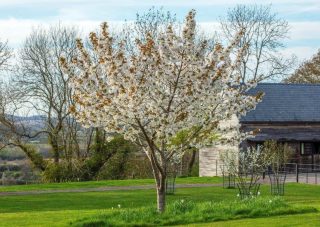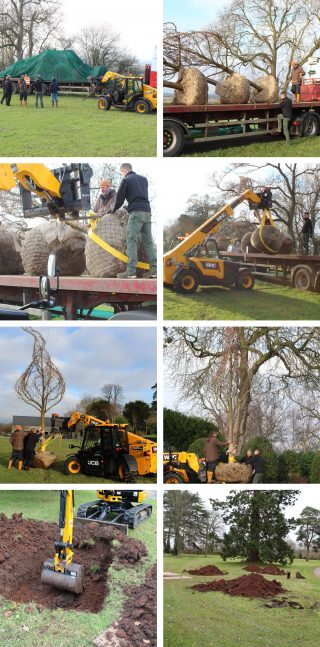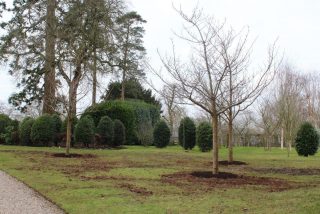Planting Giants
A Chinese proverb says "The best time to plant a tree was 20 years ago. The second-best time is now." Well, luckily, someone thought ahead at Hillier Nursery in Hampshire because this winter we have planted three Prunus ‘Tai-Haku’ trees that started their lives almost 20 years ago and are some of the largest specimens grown in the UK.
We chose Tai-Haku for its superb spring display with an abundance of
large, single, pure-white flowers without a tinge of pink, purple or
yellow. Bronze-coloured new foliage appears with the flowers in the
spring and turns to shades of orange in in the autumn. Its large
spreading canopy makes Tai-Haku one of the most impressive Japanese
cherries. Our three trees were destined for a prime position alongside
the main driveway at the entrance to the New Garden, where they will
link with the other Japanese cherries and beautifully accompany the
spring bulbs in the meadow.

Also known as the Great White Cherry, Prunus ‘Tai-Haku’ has a most remarkable history: At the end of the 19th century, mass plantings of Prunus Somei-Yoshino in Japan had caused the decline of many ancient varieties. Collingwood Ingram who became Cherry Ingram made it its mission to save these old varieties. On various journeys to Japan, he studied wild cherries in the mountains and depictions in ancient water colours. In one of these paintings, he recognized a tree which he, albeit in a sad state, had found in a Sussex Garden and taken cuttings from three years earlier. A visiting Japanese friend of his had named the unknown variety Tai-Haku. The tree in the Japanese painting, called Akatsuki had been believed to be extinct. So, Akatsuki became Tai-Haku and returned to its homeland from Cherry Ingram’s Garden!
Planting mature trees is not straightforward and requires significant
man-power and heavy machinery. Our trees arrived on an articulated
lorry, and the first challenge was to work out how to unload them
without damaging the trunks. Using a telehandler, four supporting straps
and lots of patience we were able to get the trees off the trailer,
stand them upright and transport them the short distance to the planting
holes, which had been marked out and pre-dug using a mini digger the
day before.

Next, we had to find a way to lower the trees into the planting
holes. Because of the size and weight of the root ball, we knew that we
only had one attempt. It was therefore especially important that we
measured the root ball of each tree and the size of the planting hole to
get the depth exactly right. Before lowering the trees into the holes,
we also unwrapped their canopies and orientated them so that their best
side was facing out towards the driveway from where they will mostly be
viewed. To place the trees in the holes, we used the telehandler and two
straps underneath the root ball which we carefully pulled away with the
telehandler once the trees were in position. Tilting the trees and
putting soil underneath in the right places, we managed to straighten
them.

Unbeknown to us, the biggest challenge was yet to come.
Mature trees are usually field-grown and lifted with a tree spade to be transported for planting. This means that the root balls are smaller than the root system would usually be to support such a large canopy. They take about three years to develop an anchoring root system strong enough to prevent them from blowing over when in leaf, so each tree requires additional support whilst they establish. Wooden stakes can be very unsightly, and we therefore used root anchors, a more modern alternative for fixing the root ball in the ground.
For trees this size, the root anchors needed to be pushed 1.5m into
the ground, which is when our biggest problem revealed itself: We
discovered a very hard clay layer in the soil about 1m down that we
couldn’t break through with hand tools and human strength. It became
truly clear that we needed some BIG machinery!

Therefore, before sunrise on the next morning, a large tractor with a hydraulic rammer on the back, which is normally used for fence posts, arrived. Not without effort, this monster machine eventually managed to ram the anchors into the ground. Metal wire was then tightened around the root balls and the holes were filled in. After three days, the trees had finally been planted which was a huge relief to an exhausted team! To finish, we mulched each of them with a generous layer of tree and shrub compost that will help the tree establish over the coming year.
Our thanks must go to Pip Smith for his help in sourcing and planting the trees.
Now that anguish and pain are gone, we are very excited to have three
beautiful Great White Cherries as part of the garden landscape and we
can’t wait to see their beautiful spring and autumn display for years to
come. We hope that, by the spring, the ground will have recovered from
the planting battle!

